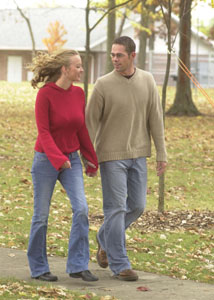By Margie Wuebker
mwuebker@dailystandard.com COLDWATER -- Courtney Firks walks hand in hand with boyfriend Matt Siefring admiring the autumn trees. Her slight limp is the only visible sign of serious injuries she sustained three years ago in a traffic accident.

The Oct. 21, 2001 crash occurred without warning. One minute members of the Firks family and Siefring were bound for a shopping mall and the next, their minivan rolled into a deep ditch along state Route 118 in Mercer County.
Hours later the pretty blonde lay in a Fort Wayne, Ind., hospital bed reeling from the prospect of spending the rest of her life in a wheelchair. An emergency room doctor had delivered a blunt prognosis -- "Your spinal cord is severed; you will never walk again.
Paralyzed from the waist down, the 19-year-old Indiana University freshman looked at her mother and asked tearfully through a morphine-induced haze, "What kind of life will I have?"
Roxanne Firks remembers the moment as if it were yesterday. She quickly assured her daughter, "You will have the same life only from a different position." Dr. Alan McGee, an orthopedic surgeon and a high school friend of her father, was on call at Parkview Memorial Hospital that day. He fused two broken vertebrae with grafts from Firks' hip and installed a rod to stabilize her spine. He emerged from the operating room tired but hopeful, explaining the accident had caused the spine to slip out of place seriously pinching, but not severing the spinal cord.
Firks said she greeted the specialist with a question -- "Will I walk again? -- as he entered the room the following day. He looked into the anxious face and admitted there was a 5 percent chance if she worked hard and prayed.
The plucky teenager, who once swam competitively and played volleyball and basketball for the Coldwater Cavaliers, endured unrelenting pain. She likens the sensations to flames licking her body from head to toe and someone jabbing dull needles deep into the tissue beneath her skin.
"I concentrated all my energy on moving even one toe," she says as memories come flooding back in torrents. "Nothing moved and it was an exhausting process. I had taken so much for granted -- even something as simple as sitting upright. I passed out the first time."
Thankfully, she said there were lighter moments like the first time she attempted to maneuver a wheelchair. Her room quickly filled with get-well cards, stuffed animals, flowers, banners and food.
"It never occurred to me at the time that I might be in the wheelchair forever," she said. "I didn't like the thing but it did give me mobility.
Therapists at the hospital did not share Firks' optimism. One caseworker expressed his sentiments more vocally than the others during an interview prior to her release. He asked about goals for the future and she immediately responded, "To walk again." He suggested setting achievable goals because walking was out of the question.
"I know his job was to prepare me for life in a wheelchair," she says. "But people like that open their mouth and take away hope. I just told him something -- anything -- to get out of there."
Firks refused all suggestions of modifications to the family's split-level home except for a wheelchair-accessible shower. She had no intention of becoming accustomed to adaptive devices when she believed recovery lurked on the horizon.
The first flicker of movement occurred shortly after a pre-Thanksgiving homecoming. She pushed her fingers deep into the right hamstring muscle like she had done many times before. Her fingertips detected an ominous twitch with more occurring elsewhere in her legs during the ensuing months. Those fleeting responses came long before subtle movements.
Firks spent four weeks at Shepherd Center, an Atlanta-based hospital geared to the treatment of catastrophic injuries and illnesses. Therapists helped her stand with the aid of special braces that locked into place.
"I can't explain how good it felt to be upright after sitting for so long," she says. "I learned to take steps using a walker and swinging my hips. I felt like I was walking on stilts."
Firks also swam laps in a heated pool. Her strong arms propelled her body, pulling her legs along behind her. Medication calmed the painful nerve firings that had plagued her since the accident.
She met many young people there -- a boy who blew through a straw to maneuver his wheelchair following a traffic accident; a girl caught in a riptide while surfing; a young man with a full soccer scholarship to a Division I school who broke his neck diving into shallow water; hunters injured in falls from deer stands. She said they looked with envy at the Coldwater woman who had full use of her arms.
Therapy continued after her return home. Progress came slowly as she graduated from wheelchair to walker and then to crutches that encircled her forearms. Surgeries corrected Achilles tendon problems in both feet.
Her first steps without a walker or cane came during a vacation with friends. She repeated the process later for her unsuspecting parents. They cried tears of joy and so did she. The same thing happened when she rode a bicycle down the street for the first time since the accident.
Firks, now a 22-year-old finance and accounting major at the University of Dayton, considers herself fortunate to require nothing more than a short brace on her left leg. She has no secret formula or magic prescription to explain the dramatic recovery. Even her doctor is amazed. Of three similar cases he has treated, she is the only one to make a walking recovery.
"I steer clear of the words 'I can't' because that would mean placing limitations on myself," she says. "I prefer to focus on what I can do and not worry about the rest. Running and jumping are superficial; walking is so much more important." |

